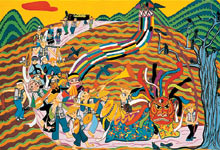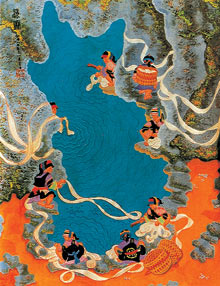| Artistic License 民间绘画艺术 |
| http://www.sina.com.cn 2004/11/23 19:32 thats China |
 "Picking Mushrooms in the Stone Forest" by Jiang Qingyun Such propaganda art became less widespread in the 1960s, but many of the artists continued to paint recreationally - and when they did, they maintained the unrealistic style they had become accustomed to. The amateur painters formed village art groups where they could meet and exchange ideas.
Soon, there were movements to develop the style into a professional art form, says Sun Jianjun, the Deputy Director of the Folk Arts and Crafts Commission and a dean at the Chinese Academy of Art. "Local cultural and folk art associations used funds to train the farmers in basic painting skills, especially in the use of colors," Sun says. "Many of the farmers welcomed the guidance, but it was important for them to maintain their individualistic painting style. This is still true today." More than 40 government-recognized farmer's painting communities currently exist across China and each community's works have developed a strong sense of local charm. Though it can take an experienced eye to distinguish one area's artwork from the next, a basic knowledge of China's terrain can make distinguishing a painting's source a lot easier.
"The farmers' painting themes reflect everyday village life and surroundings," says Sun. "If the painting has a water theme, for example, it's likely that it comes from a village near the sea. It's easy to recognize paintings from coastal cities like Tianjin because they often depict water themes in their paintings," he says. Huxian County in Shaanxi Province is known as the oldest folk painting region in China. Artists there have become world-renowned for portraying the ordinary aspects of county life on blackboards and newspapers and in large murals. Acclaimed for their inventive style, the paintings have generated interest both at home and abroad, where they've been displayed in such countries as the United States, Singapore and Australia.
In 2002, the county hosted an international peasant painting exhibition for folk artists from all over China and overseas. This month, more artists will journey to the county for a Huxian peasant painting festival. Jinshan District in southeast Shanghai has emerged as another recognized place for folk paintings, particularly since the 1970s. Huai Mingfu, the director of the Jinshan Peasant Painting Academy, says that artists in this region are known for their gouache (opaque watercolor) paintings on xuan paper, or rice paper. The works have been shown in more than 20 countries in Europe, North America and Asia, as well as Australia. |
|
|
|
|
|
| Annotation |
| 新闻查询帮助 | |
| 热 点 专 题 | ||||
| ||||
|
教育频道意见反馈留言板 电话:010-62630930-5178 欢迎批评指正
新浪简介 | About Sina | 广告服务 | 联系我们 | 招聘信息 | 网站律师 | SINA English | 会员注册 | 产品答疑
Copyright © 1996 - 2004 SINA Inc. All Rights Reserved
版权所有 新浪网![]() 北京市通信公司提供网络带宽
北京市通信公司提供网络带宽


